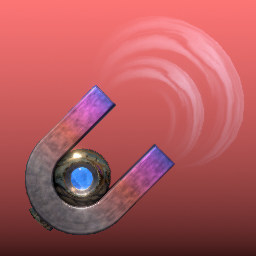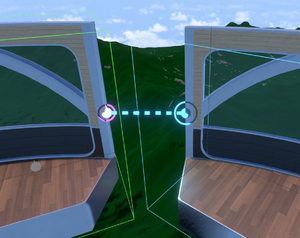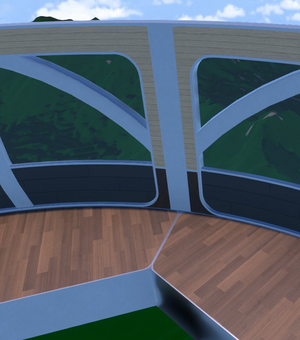No edit summary |
Examples added, context menu updated. |
||
| (9 intermediate revisions by 5 users not shown) | |||
| Line 1: | Line 1: | ||
The '''Module Snapping Tool''' is a common editing | [[file:ModuleSnapTool.png|thumb|The module snapping tool|alt=Resonite module snapping tool being a magnet with a magnetic aura at its end]] | ||
The '''Module Snapping Tool''' is a common editing [[Tools|tool]] which allows the user to snap together modular components which have been set up for it, such as those found in the [[Dawn Modular]] set that the [[Resonite Cloud Home|Cloud Home]] is made out of. | |||
== Spawning the Module Snapping Tool == | == Spawning the Module Snapping Tool == | ||
The Module Snapping Tool may be found in the Resonite Essentials [[Public Folders|public folder]] that every user has in their [[inventory]], under the Tools | The Module Snapping Tool may be found in the Resonite Essentials [[Public Folders|public folder]] that every user has in their [[inventory]], under the Tools -> Custom folder directory. | ||
== Using the Module Snapping Tool == | == Using the Module Snapping Tool == | ||
| Line 9: | Line 11: | ||
When the tool is equipped, components with a "Snap Points" slot will be highlighted with a purple box when scrolled over. | When the tool is equipped, components with a "Snap Points" slot will be highlighted with a purple box when scrolled over. | ||
[[File:ModuleSnapExample1.png|thumb|Module on the right will snap to the module on the left as it was selected first.]] | |||
Primary clicking while an object is highlighted will select it as the part to be moved, and show a display of the available Snap Points. | Primary clicking while an object is highlighted will select it as the part to be moved, and show a display of the available Snap Points. | ||
Clicking on a Snap Point will select it as the location which the object will attach at, and allow you to select the second object. | Clicking on a Snap Point will select it as the location which the object will attach at, and allow you to select the second object. | ||
| Line 18: | Line 20: | ||
Clicking a point on the second object will cause the first object to "snap" to the position and rotation of the point on the other object, while also scaling itself to the same size and parenting itself to that object's parent. | Clicking a point on the second object will cause the first object to "snap" to the position and rotation of the point on the other object, while also scaling itself to the same size and parenting itself to that object's parent. | ||
This process can be | This process can be canceled at any time by pressing [[Basic_Controls|Secondary / R key]] | ||
=== Options === | |||
[[File:ModuleSnapExample2.png|thumb|After clicking on the purple sphere/dot.]] | |||
While the Module Snapping Tool is equipped, your [[context menu]] will gain options to allow you to switch between different options. | |||
===== Snap Conditions: ===== | |||
* '''Only Allowed''': Will only snap points whose names are in a pre-defined set of "allowed" snaps. | |||
* '''Allowed or Self''': Will allow both the pre-defined snaps, AND snapping to points which are the same. | |||
* '''Any''': Will allow the snapping of any two points, regardless of their names. | |||
===== Mode: ===== | |||
* '''Build:''' Default mode. Modules move when they snap. | |||
* '''Duplicate:''' Behaves much like Build, but instead of moving, the module is duplicated. | |||
* '''Delete:''' Clicking on an allread selected module deletes the module. | |||
== Setting up a Modular Part for Snapping == | == Setting up a Modular Part for Snapping == | ||
| Line 29: | Line 46: | ||
The names of the Snap Point slots matter, as the Tool has an optional filter (on by default) which uses the names of these slots to decide what to display or not. | The names of the Snap Point slots matter, as the Tool has an optional filter (on by default) which uses the names of these slots to decide what to display or not. | ||
It is highly recommend that you use building parts from either Dawn Modular (official) or Dusk Modular (simpler), as reference for positions and names, even aligning the slots and copying them directly, so that your modular parts will be compatible with the existing part standard. | It is highly recommend that you use building parts from either [[Dawn Modular]] (official) or [[Dusk Modular]] (simpler), as reference for positions and names, even aligning the slots and copying them directly, so that your modular parts will be compatible with the existing part standard. | ||
[[ | [[Category: Tools]] | ||
Latest revision as of 04:52, 4 November 2025

The Module Snapping Tool is a common editing tool which allows the user to snap together modular components which have been set up for it, such as those found in the Dawn Modular set that the Cloud Home is made out of.
Spawning the Module Snapping Tool
The Module Snapping Tool may be found in the Resonite Essentials public folder that every user has in their inventory, under the Tools -> Custom folder directory.
Using the Module Snapping Tool
The Module Snapping Tool can be equipped by clicking it, but requires Builder Permissions, like most other tools.
When the tool is equipped, components with a "Snap Points" slot will be highlighted with a purple box when scrolled over.

Primary clicking while an object is highlighted will select it as the part to be moved, and show a display of the available Snap Points.
Clicking on a Snap Point will select it as the location which the object will attach at, and allow you to select the second object.
Clicking on a second purple-box highlighted object will show the snap points to which you can link the first object to using the point you've selected on it: note that there is a filter which can be disabled in the Radial Menu.
Clicking a point on the second object will cause the first object to "snap" to the position and rotation of the point on the other object, while also scaling itself to the same size and parenting itself to that object's parent.
This process can be canceled at any time by pressing Secondary / R key
Options

While the Module Snapping Tool is equipped, your context menu will gain options to allow you to switch between different options.
Snap Conditions:
- Only Allowed: Will only snap points whose names are in a pre-defined set of "allowed" snaps.
- Allowed or Self: Will allow both the pre-defined snaps, AND snapping to points which are the same.
- Any: Will allow the snapping of any two points, regardless of their names.
Mode:
- Build: Default mode. Modules move when they snap.
- Duplicate: Behaves much like Build, but instead of moving, the module is duplicated.
- Delete: Clicking on an allread selected module deletes the module.
Setting up a Modular Part for Snapping
The Module Snapping Tool works by finding a slot within an object's hierarchy named "Snap Points", and moving the position, rotation, and scale of slot with the Object Root component to mirror the Snap Point of the second object along the Z plane.
This means, to set up a modular component for it, you must give the top-level slot of the object an Object Root component, and make a slot somewhere beneath it named "Snap Points". Do not change the rotation, location, or scale from their default 0s and 1s, as this will offset all transformations applied.
Snap Points themselves are basically just slots inside of the snap points with positions, rotations, and (potentially) scale. The module snapping tool will effectively drag the objects around until these points are at the exact same locations with rotations perfectly mirrored along the z-plane. A good point of reference is that the Z axis should be pointed outwards, towards the other object.
The names of the Snap Point slots matter, as the Tool has an optional filter (on by default) which uses the names of these slots to decide what to display or not.
It is highly recommend that you use building parts from either Dawn Modular (official) or Dusk Modular (simpler), as reference for positions and names, even aligning the slots and copying them directly, so that your modular parts will be compatible with the existing part standard.